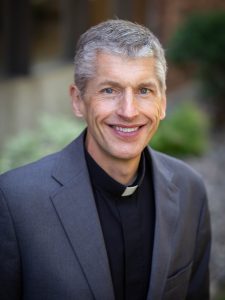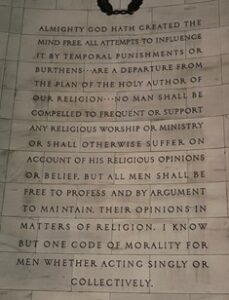 By Pastor Craig Pederson
By Pastor Craig Pederson
Last month brought to a close the seven-year experience of our daughter, Nora, playing AAU summer basketball. The past few summers had us traveling to destinations beyond the many weekend tournaments held in the Twin Cities: St. Cloud, Chicago, Indianapolis, and Ames, Iowa, among them. Nora’s final tournament was in Washington D.C., offering the opportunity to turn her basketball trip into a family vacation.
I had not been to Washington D.C. since I was a young adult. It was a very different city, and a very different world, in the early 1990’s. The national monuments, museums, and halls of government all retain their historical locations and significance. But our domestic and international politics, as well as the city itself, have undergone dizzying cycles of transition over the past 30 years.
In the current moment, with a bitterly divided federal government and a third indictment against our former president recently announced, it’s easy to be cynical about the future of Washington D.C. and the direction of our country. But as we traversed the city and visited some of our national institutions, the civic and religious idealism of my young adult years began to reverberate through my mind and spirit.

D.C. pulses with a beautiful diversity of God’s people from all over the planet. It was a moving experience to stand next to Chinese, Latino, and African American families in the National Archives Museum while viewing our nation’s Constitution. Later, walking slowly alongside young and old Americans from diverse backgrounds through the Smithsonian’s National Museum of the American Indian produced a collective reverence I did not expect.
The national monuments to our former presidents are remarkable architectural works. And while the legacies of these founders continue to be reviewed and even scrutinized through updated lenses of equity and justice, they were inarguably inspired by a higher purpose as they conceived the values upon which a new nation would be built.
My worldview has been altered over the decades by the sober realism of contemporary politics and institutional religious challenges. I still believe, however, that there are “braver angels” within all of us that would have us believe we hold more in common with our fellow national and global citizens than that which divides us.

THIS SPIRIT AND HOPE for unity was poignant throughout our trip, but two brief experiences remain with me. The first was at the National Museum for the American Indian, where the history of indigenous mistreatment by white settlers and government institutions is explained in matter-of-fact exhibits and displays. One display recounts the indigenous tribal leader Powhatan, who in 1608 anticipated the arrival of troops in the Chesapeake Bay area under the direction of Captain John Smith:
“For many do inform me your coming is not for trade,
But to invade my people and possess my country . . .
To cheer us of this fear, leave aboard your weapons.
For here they are needless, us all being friends.”
Sadly, this entreaty was not heeded, and years of conflict ensued in the Anglo-Powhatan Wars that foreshadowed centuries of other Anglo-indigenous conflicts.
The second was a fascinating interactive display at the Smithsonian’s Natural History Museum that shows how global ocean conditions affect demographics, climate, agriculture, and sea life patterns. Human impact on climate change is well-documented – this spherical representation brings this impact to life in no uncertain terms.


The takeaway for me was this: while governments, militaries, and business enterprises go to great lengths to identify the boundaries of our oceans, the 71% of our planet made up of water functions as one body, one resource, one element of creation. To deny or minimize that unifying reality is done at the peril of all of us.
The 71% of our planet made up of water functions as one body, one resource, one element of creation.
In this United States of America, unity is not uniformity. We are united by the values and commitments that lift the fortunes of everyone. The same goes for the Church. We may have differing opinions, worship styles, or cultural traditions, but our unity in Christ serves as the higher purpose that connects us to our Creator.
As our liturgy proclaims, “For the peace of the whole world, for the well-being of the church of God, and for the unity of us all, let us pray to the Lord . . . Lord, have mercy.” Amen!
